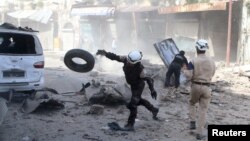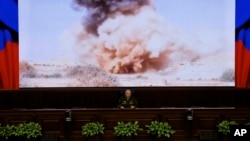Russia and Iran are gearing up around the key northern Syrian city of Aleppo in what appears to be the beginning of a renewed push to shore up the regime of President Bashar al-Assad.
“We have seen regime forces, with some Russian support as well, begin to mass and concentrate combat power around Aleppo,” Operation Inherent Resolve spokesman Colonel Steve Warren told Pentagon reporters during a telephone briefing Wednesday.
“This is something we’re concerned about,” he added.
U.S. defense and intelligence officials say Russia has been steadily bolstering its presence around Aleppo, shifting much of the artillery used in the offensive to retake Palmyra from Islamic State militants up north.
Russian aircraft, helicopters and troops have also been moving toward Aleppo over the past several weeks, they say.
At the same time, hundreds of Iranian-backed Shia militia fighters are converging on the area to bolster existing regime forces.
Endgame
“The Syrian regime seems to be driving towards the eventual isolation of opposition forces in and around Aleppo,” a U.S. intelligence official said on condition of anonymity.
The official said at least in the area north of Aleppo, Russian actions appeared to be in support of the Syrian regime, aimed at cutting off the supply lines for moderate opposition forces.
“We also see indications of fighting southwest of Aleppo between Syrian forces with Russian backing and opposition elements,” the official added.
Russian officials have long said their actions in Syria have been aimed at terror groups such as Islamic State and al-Qaida-linked Jabhat al-Nusra, and U.S. officials admit Russia has picked up the pace of airstrikes on terror targets.
But analysts caution the type of Russian equipment being sent to Aleppo suggests not just a different enemy in the short term but also a broader strategic endgame.
“Russia has begun to alter the shape of its own deployment,” Institute for the Study of War analyst Genevieve Casagrande said during a panel discussion Wednesday.
“These types of military assets aren’t necessarily used, you don’t actually need them to fight ISIS,” she said, using an acronym for Islamic State.
Iranian role
While Russian forces seem to be the primary driver behind the looming offensive in Aleppo, providing critical air support and heavy weapons, Iranian-backed Shia militias have also been playing a critical role.
“Many of the Shia militia forces continued to fight even during the cease-fire,” said Phillip Smyth, a University of Maryland researcher who specializes in Shia militia activity. “They've seen a greater and more open deployment around the country, particularly in the areas around Aleppo.”
Despite seeing heavier casualties across Syria earlier in the year, Iran has continued to recruit Shias from Iraq and elsewhere to join the fight, again increasing its online efforts, Smyth said.
He estimates there could be 14,000 or more Iranian-backed Shia fighters in Syria as well as another 3,500 Iranian troops.
For now, U.S. defense officials say developments around Aleppo are unlikely to affect the U.S.-led coalition effort to destroy the Islamic State terror group, though one official said it could influence operations peripherally.










